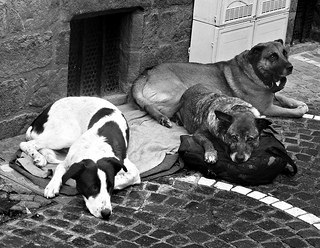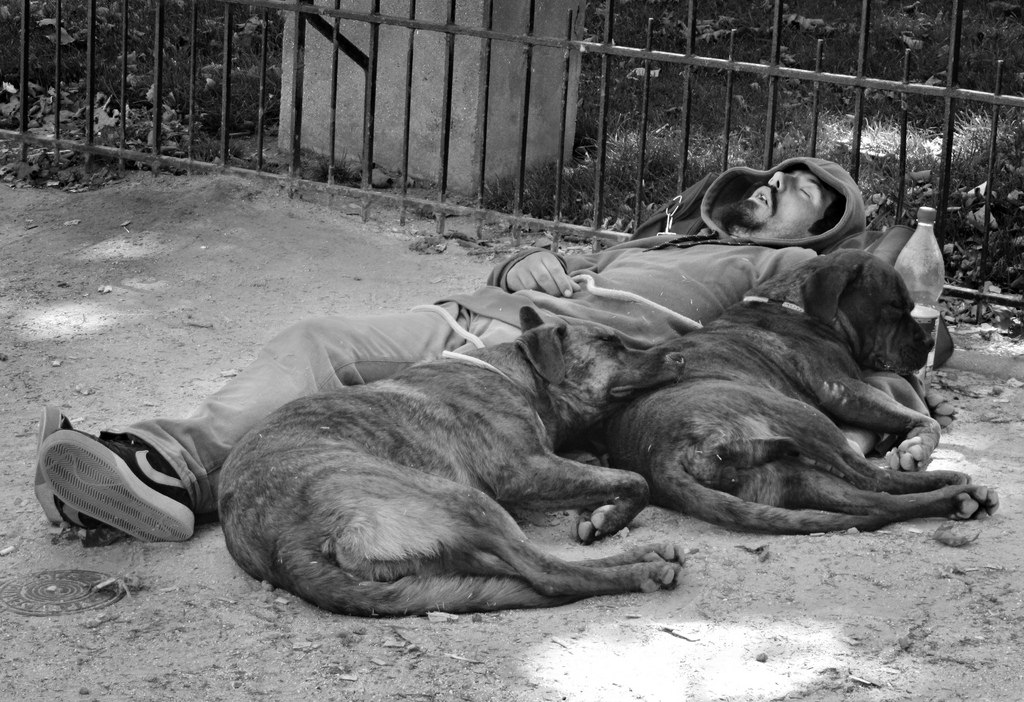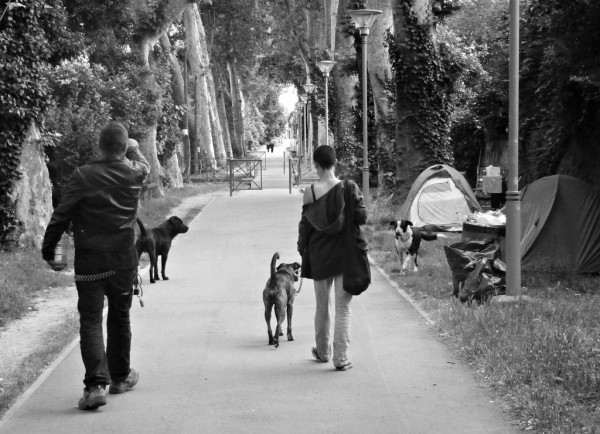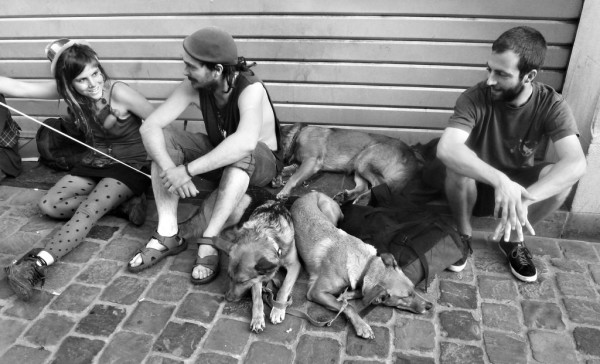I first noticed them in Paris: dogs accompanying homeless street people. I saw a man in a heavy winter coat sitting on the stone ground of a bridge while his dog—a rust-colored lab puppy—rested, curled up, on a blanket beside him. A sign said the dog was for sale. It hit me hard: he was obviously caring for this animal, but it was mid-October, and there was a chill in the air. Surviving the winter can be a challenge for human beings, let alone animals.
 A year later, I visited Europe again with my wife and our two adult children. My daughter said she wanted to create a calendar of dogs, so I fell into the pattern of taking photos of street dogs. Occasionally, dogs traveled with human companions, and I photographed them, too. Usually, the street people were alone with their dogs, or with one other street person. Occasionally, we saw them gathered in large numbers. One image that has stayed with me is the thick crowd of street people and their dogs that formed in front of the Matabiau train station in Toulouse at sunset, waiting for a van that delivered blankets and provided health care after dark.
A year later, I visited Europe again with my wife and our two adult children. My daughter said she wanted to create a calendar of dogs, so I fell into the pattern of taking photos of street dogs. Occasionally, dogs traveled with human companions, and I photographed them, too. Usually, the street people were alone with their dogs, or with one other street person. Occasionally, we saw them gathered in large numbers. One image that has stayed with me is the thick crowd of street people and their dogs that formed in front of the Matabiau train station in Toulouse at sunset, waiting for a van that delivered blankets and provided health care after dark.
I made several more trips to Europe over the next few years. Everywhere, I kept seeing street people and their dogs—more, it seemed, with each trip. The photos for this essay were taken between 2010 and 2013 in a variety of cities: Paris, Toulouse, and Lille, France; Brussels, Belgium; and, Edinburgh, Scotland.
To my knowledge, no one keeps a formal tally of the number of street people who travel with animal companions. Anecdotally, the number appears to have gone up in many parts of France over the last two decades, says Charlotte Nivelet, a French ethologist with the International Fund for Animal Welfare (IFAW). The young, she adds, are more likely to be what the French call “travelers”—the untranslated English word used in that country to describe street people accompanied by animals, usually dogs.
In France, being a traveler has advantages and disadvantages. On the one hand, an emergency shelter will not admit a homeless person who has an animal. On the other hand, traveling with that animal provides a measure of protection—and not just the security of a watchdog to scare off attackers or wake you up when there’s trouble. If the police happen to arrest the human companion, they cannot jail the animal one, nor can they just abandon it on the streets. “Instead, they must house the dog in a special dog hotel,” says Sandrine Guilhem, a community activist in Toulouse. “For most offenses, that’s too much trouble and costs too much money, so the police simply do not prosecute travelers for minor offenses such as riding on a train without a ticket.” (The same goes for psychiatric hospitals, Guilhem notes: they can’t forcibly institutionalize a homeless person without providing separate lodging for the animal.)
 Coming across so many of these travelers during my trips to Europe made me think about the relationships they have with their animals. Many people might ask, for instance, how a homeless person who can barely take care of himself can take decent care of an animal. The more cynical might even accuse the homeless of using their animals to milk the sympathies of passersby. What I observed was something different. The homeless people I met were with their animals day and night, looking out for their welfare at all times. They didn’t leave their dogs in cages all day—the way some people do when they leave for work. The man with the sign in Paris was the only street person I ever saw who was selling an animal.
Coming across so many of these travelers during my trips to Europe made me think about the relationships they have with their animals. Many people might ask, for instance, how a homeless person who can barely take care of himself can take decent care of an animal. The more cynical might even accuse the homeless of using their animals to milk the sympathies of passersby. What I observed was something different. The homeless people I met were with their animals day and night, looking out for their welfare at all times. They didn’t leave their dogs in cages all day—the way some people do when they leave for work. The man with the sign in Paris was the only street person I ever saw who was selling an animal.
The loyalty the homeless people showed their dogs, in turn, seemed to be avidly reciprocated. The dogs protected their owners against attacks at night. They served as peacekeepers when large numbers of street people gathered at sunset, as in front of the train station, and tensions rose. The dogs, who knew each other well, would walk in intersecting circles, helping maintain a safe distance between their respective masters until tempers calmed.
Whether the homeless have the financial wherewithal to adequately care for their animals is another matter—and one that some advocacy groups are trying to address. In France, the IFAW has been developing ways to assist homeless animals (usually dogs) and humans in tandem, so that the animal is cared for while the homeless person is taking steps toward reintegration into society: attending training, going to job interviews, seeing a doctor, and so on.
In the United States, Pets of the Homeless operates a nationwide network to help street people and their animals stay together. Among other things, the nonprofit organization provides the homeless with free veterinary care and food for their animals. “We get lots of calls from people who are about to become, or just became, homeless,” says Genevieve Frederick, the organization’s founder. “They’ll ask, ‘What am I going to do about my dog?’ They don’t want to be separated.” As Frederick notes, homelessness is usually a temporary condition, which means there is little reason for street people and their animals to be permanently split up.
Legend has it that street people first traveled with dogs in large numbers in the French town of Montpellier. If this way of life really began in Montpellier, there’s something curiously wonderful about that. Montpellier is the birthplace of St. Roch, a fourteenth-century mendicant pilgrim and ascetic, the patron saint of dogs and dog lovers.
According to accounts of Roch’s life, the governor of Montpellier—Roch’s father—decreed on his deathbed that his son would succeed him. Roch would have none of that. Instead, he gave away his wealth to the poor. When he fell victim to the plague, Roch hid in the forest, expecting to die there. As the story goes, a dog began to visit him every day, bringing him stolen food and licking his wounds. (For that reason, depictions of Roch usually show his left hand lifting his tunic to reveal a wound on his thigh, while his right hand accepts stolen food from an attentive dog.) After the dog nursed him back to health, Roch traveled throughout Italy healing others.
 In a sense, today’s travelers are much like Roch: outcasts nursing wounds. For them, says the IFAW’s Nivelet, animals are “a lifeline, a family, a safeguard, an antidepressant”—a way to cope with an intensely precarious and disheartening state of being. “At times it is this bond,” Nivelet adds, “that represents the final safety net before a total break from society.”
In a sense, today’s travelers are much like Roch: outcasts nursing wounds. For them, says the IFAW’s Nivelet, animals are “a lifeline, a family, a safeguard, an antidepressant”—a way to cope with an intensely precarious and disheartening state of being. “At times it is this bond,” Nivelet adds, “that represents the final safety net before a total break from society.”
University of Colorado sociologist Leslie Irvine has conducted interviews with people who live on the streets with their animals. In her 2013 book My Dog Always Eats First: Homeless People and Their Animals, these individuals describe their animal companions as life changers and lifesavers—sources of unconditional love who encourage them to be more responsible caretakers, silent witnesses who keep them from falling back into risky behaviors.
In turn, animals can help the homeless stay connected to the rest of humanity. As Frederick points out, people who normally never approach a homeless person living on the street react to them differently when they see them with an animal. They will first interact with the animal, petting it or talking to it, and then, once they feel more comfortable, they will begin to chat with the animal’s human companion. “Having an animal helps homeless people open up communication with non-homeless humans, who see them as caring,” Frederick says.
I like to believe that having an animal companion deepens the compassion of homeless people, who often live relatively solitary lives. And perhaps seeing these travelers with their dogs also deepens the compassion of those of us just walking by. If at first we’re drawn to the dog, with any luck we get to know its human companion, too. We recognize and relate to that age-old bond between human and animal. And maybe we walk away changed, having known the homeless not as panhandlers or social burdens, but as other caring human beings.
A health researcher by profession, Jim Ross has published stories and photos in the Atlantic, Friends Journal, Pif Magazine, and Lunch Ticket, among other publications. He resides in Silver Spring, Maryland, and Berkeley Springs, West Virginia. He can be reached at jamesross355@gmail.com.
- Follow us on Twitter: @inthefray
- Comment on stories or like us on Facebook
- Subscribe to our free email newsletter
- Send us your writing, photography, or artwork
- Republish our Creative Commons-licensed content



